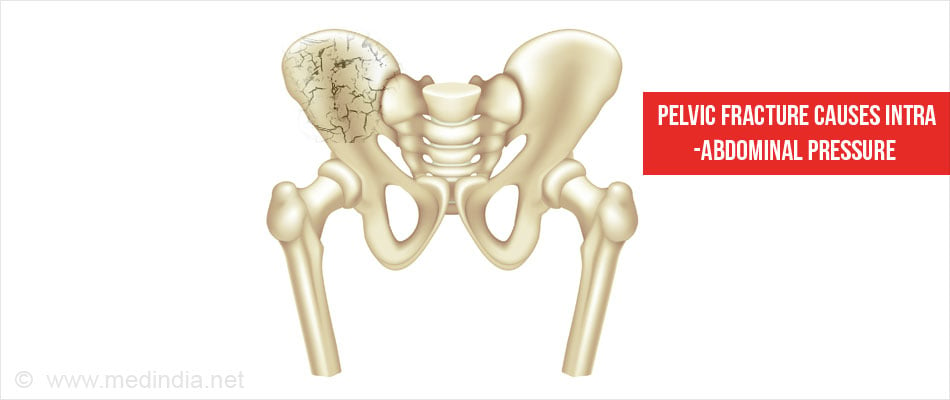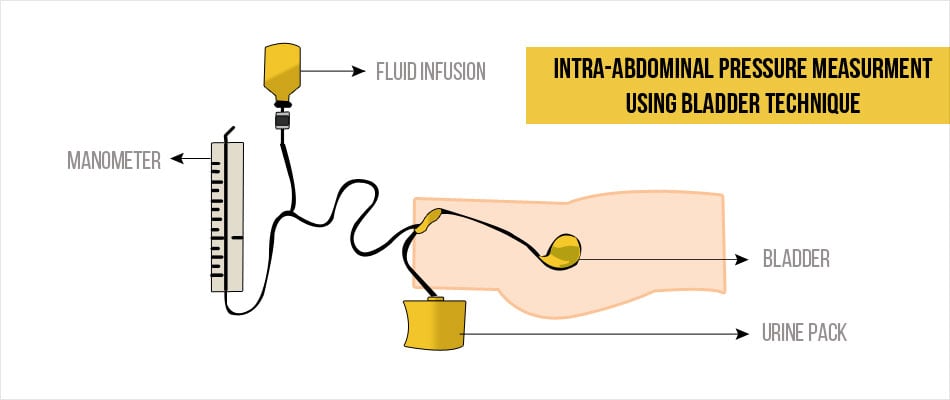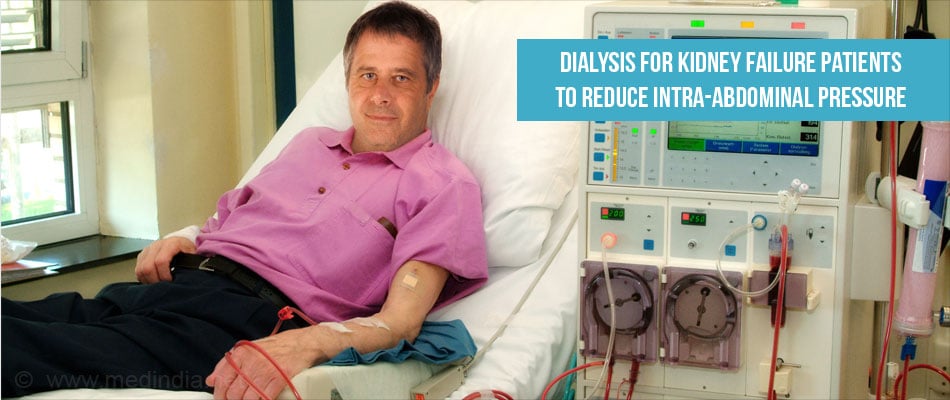- Abdominal Compartment Syndrome: Risk Factors, Diagnosis, and Current Therapy - (http://dx.doi.org/10.1155/2012/908169)
- Hunt L, Frost SA, Hillman K, Newton PJ, Davidson PM. Management of intra-abdominal hypertension and abdominal compartment syndrome: a review. J Trauma Manage Outcomes (2014) 8: 2. doi:10.1186/1752-2897-8-2
- Kirkpatrick AW et al. Intra-abdominal hypertension and the abdominal compartment syndrome: updated consensus definitions and clinical practice guidelines from the World Society of the Abdominal Compartment Syndrome. Intensive Care Medicine. 2013; 39 (7): 1190 -1206.
What is Abdominal Compartment Syndrome?
Abdominal compartment syndrome is defined as an intra-abdominal pressure of more than 20 mm Hg that results in the failure of an organ like the kidney or the lung.
The normal intraabdominal pressure, which is the pressure within the abdomen, usually ranges between 5 and 7 mm Hg, with a maximum pressure of 12 mm Hg considered as normal. Intra-abdominal hypertension is defined as a sustained elevation of intra-abdominal pressure of more than 12 mm Hg. The following grades have been assigned for intra-abdominal hypertension:

- Grade I for an intra-abdominal pressure of 12-15 mm Hg
- Grade II for an intra-abdominal pressure of 16-20 mm Hg
- Grade III for an intra-abdominal pressure of 21-25 mm Hg
- Grade IV for an intra-abdominal pressure of more than 25 mm Hg
What are the Causes of Abdominal Compartment Syndrome?
Abdominal compartment syndrome may arise due to condition in the abdomen, or outside the abdomen. Depending on the cause, abdominal compartment syndrome is classified as:
- Primary abdominal compartment syndrome occurs due to bleeding within the abdominal or pelvic region, which may be due to one of the following conditions:
- Following a surgical procedure
- Disease like a perforated peptic ulcer or rupture of abdominal aortic aneurysm
- Trauma due from an injury like a penetrating injury or a pelvic fracture

The condition usually requires early surgical treatment or radiological intervention.
- Secondary abdominal compartment syndrome occurs in patients who have received a large amount of fluid for the treatment of conditions like sepsis, burns or severe blood loss. Thus, the cause is a condition that originates outside the abdominal or pelvic region.
- Recurrent abdominal compartment syndrome refers to the recurrence of abdominal compartment syndrome following treatment for primary or secondary abdominal compartment syndrome.
Patients at risk of developing abdominal compartment syndrome include those with:
- Reduced expansion of the abdominal wall due to abdominal surgery, trauma, severe burns or prone positioning (where the patient is kept lying on the stomach)
- Problems of the digestive tract like intestinal obstruction, or stomach or intestinal dilatation
- Abdominal problems outside the digestive tract like fluid accumulation, an abscess, a tumor, or increased air pressure due to air insufflation during a laparoscopy procedure
- Leakage of fluid from blood capillaries due to conditions like sepsis
- Other conditions like increased blood clotting and obesity
What are the Symptoms of Abdominal Compartment Syndrome?
Some of the changes that occur due to the increase in intra-abdominal pressure include:
- Decreased return of venous blood from the lower part of the body through the inferior vena cava to the heart. This reduces the output of blood from the heart and thereby reduces blood flow to organs like the kidney, liver, digestive tract and the central nervous system
- The diaphragm is pushed upwards, which restricts lung expansion
- Kidney dysfunction may occur resulting in reduced urinary outflow and water retention. It may progress to kidney failure
- Liver and gut edema may occur in due course
Some symptoms and signs of abdominal compartment syndrome include:
- Pain in the abdomen
- Tense, tight abdomen
- Increase in girth of the abdomen
- Unstable hemodynamics that includes altered heart rate, blood pressure.
- Reduction in urine output
How Do You Diagnose Abdominal Compartment Syndrome?
Diagnosis of abdominal compartment syndrome is based on the measurement of the pressure in the urinary bladder via a urinary catheter with the patient in lying down position. This pressure reflects the intra-abdominal pressure. An upper limit of 25cc fluid is introduced into the bladder during the procedure.

Measurement of intra-abdominal pressure via the urinary bladder may not be possible in patients with bladder problems. In such patients, the intra-abdominal pressure may be measured by a tube inserted into the stomach, a catheter inserted via the femoral vein into the inferior vena cava, or direct measurement of the pressure in the abdomen.
Continuous measurement of the intraabdominal pressure is preferred to intermittent measurement in some cases.
How Do You Treat Abdominal Compartment Syndrome?
Treatment of abdominal compartment syndrome is carried out in a critical care unit. The intra-abdominal pressure is reduced so that the blood supply to the abdominal organs is not affected and damage is prevented. The treatment includes the following:
Supportive care:
- The body should be positioned in such a way that the head end is at an angle of less than 30 degrees
- Artificial ventilation may be necessary for people who cannot breathe efficiently
- Antibiotics may be needed to treat infection
- Medications are required to relieve pain and thereby improve abdominal wall movement
- Blood flow to organs is maintained through drugs that increase blood pressure and the judicious use of fluid
Approaches to reduce intra-abdominal pressure:
- Diuretics or water pills like furosemide are required to reduce water content in the body and bowel edema
- Dialysis may be used in patients with kidney failure

- Ascites can be reduced by draining the fluid accumulated in the abdomen
- Gastric distention is relieved by using a tube that is inserted into the stomach via the nose or the mouth. Fecal impaction should also be treated
Surgery:
- A surgical procedure called decompressive laparotomy is used during which the abdomen is opened to relieve the abdominal pressure and is temporarily closed. Repeated such surgeries may be required before a final decision to close the abdomen permanently is taken. The final closure is often performed 6 to 12 months after the initial surgical decompression procedure to give time for the inflammation to subside.
Health Tips
- Patients at risk for abdominal compartment syndrome should be frequently monitored.
- The amount of fluids used to resuscitate a patient should have an upper limit and should be administered while monitoring several parameters.
- The patient should receive adequate vitamins and zinc to promote wound healing.










